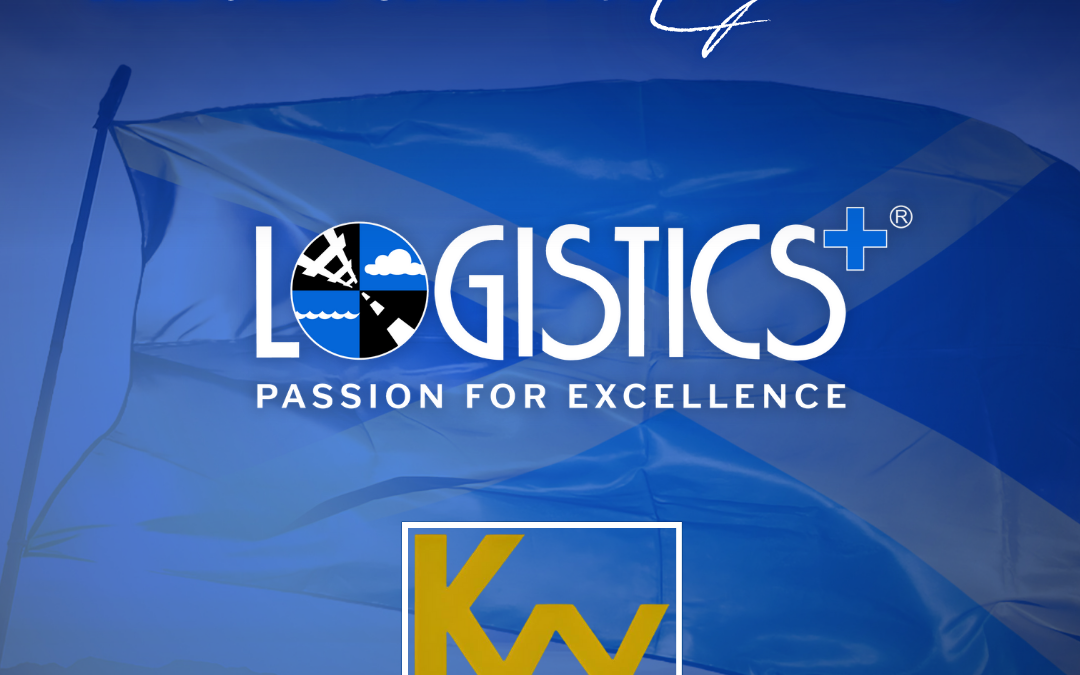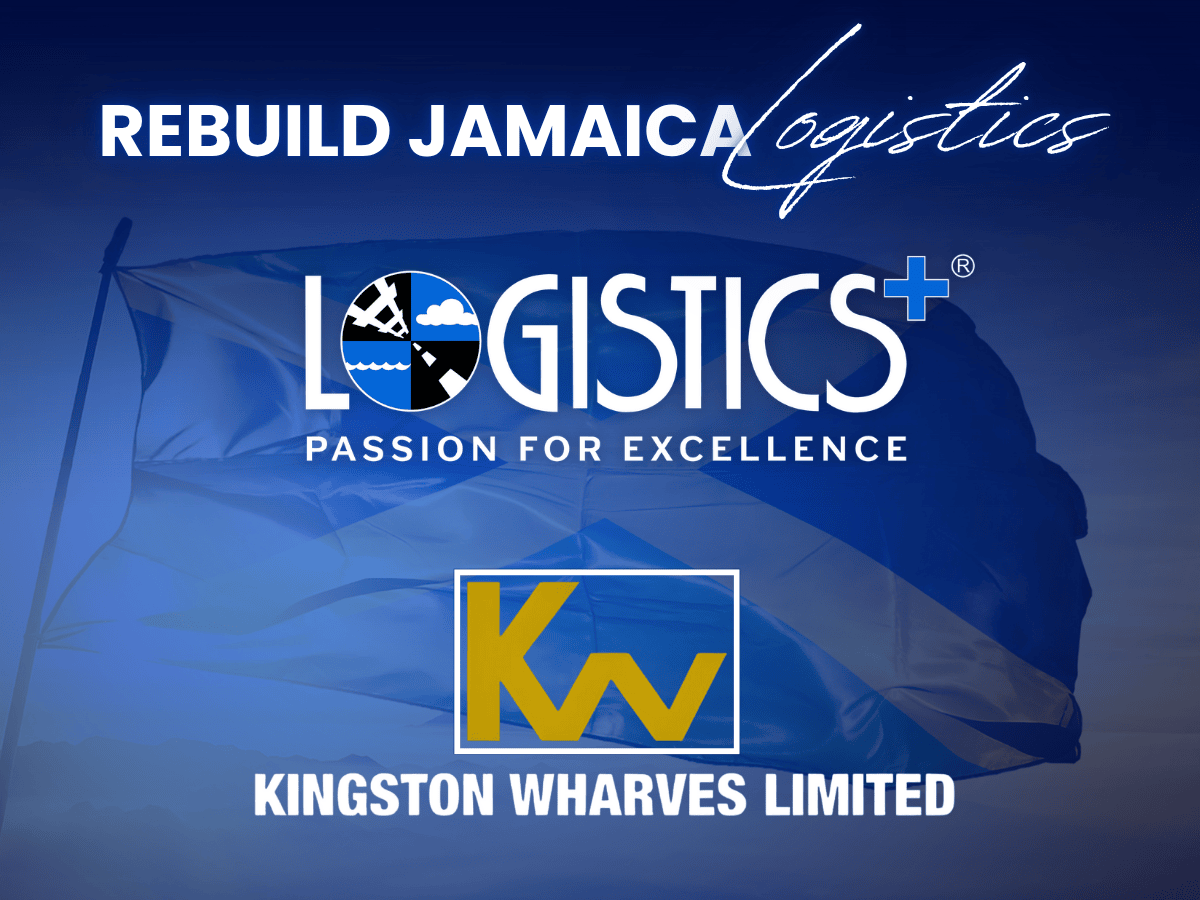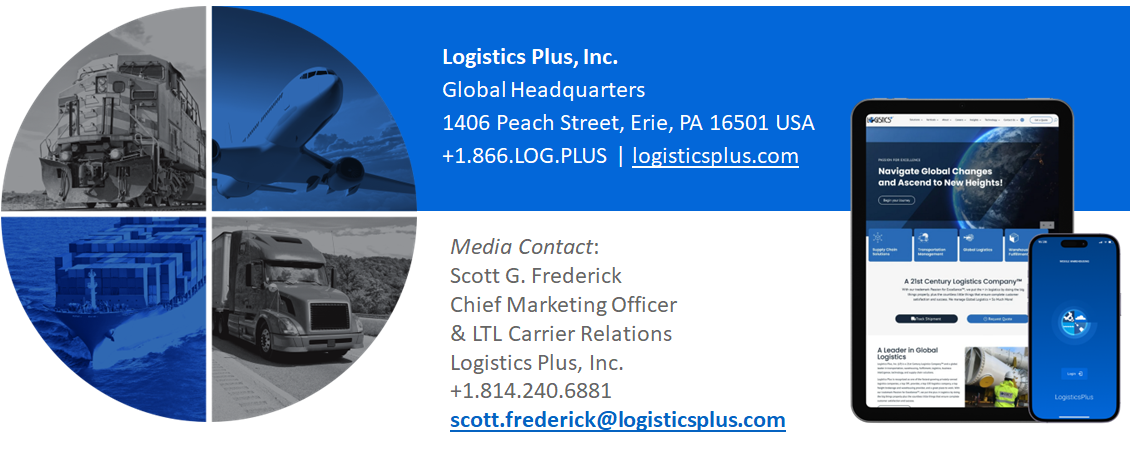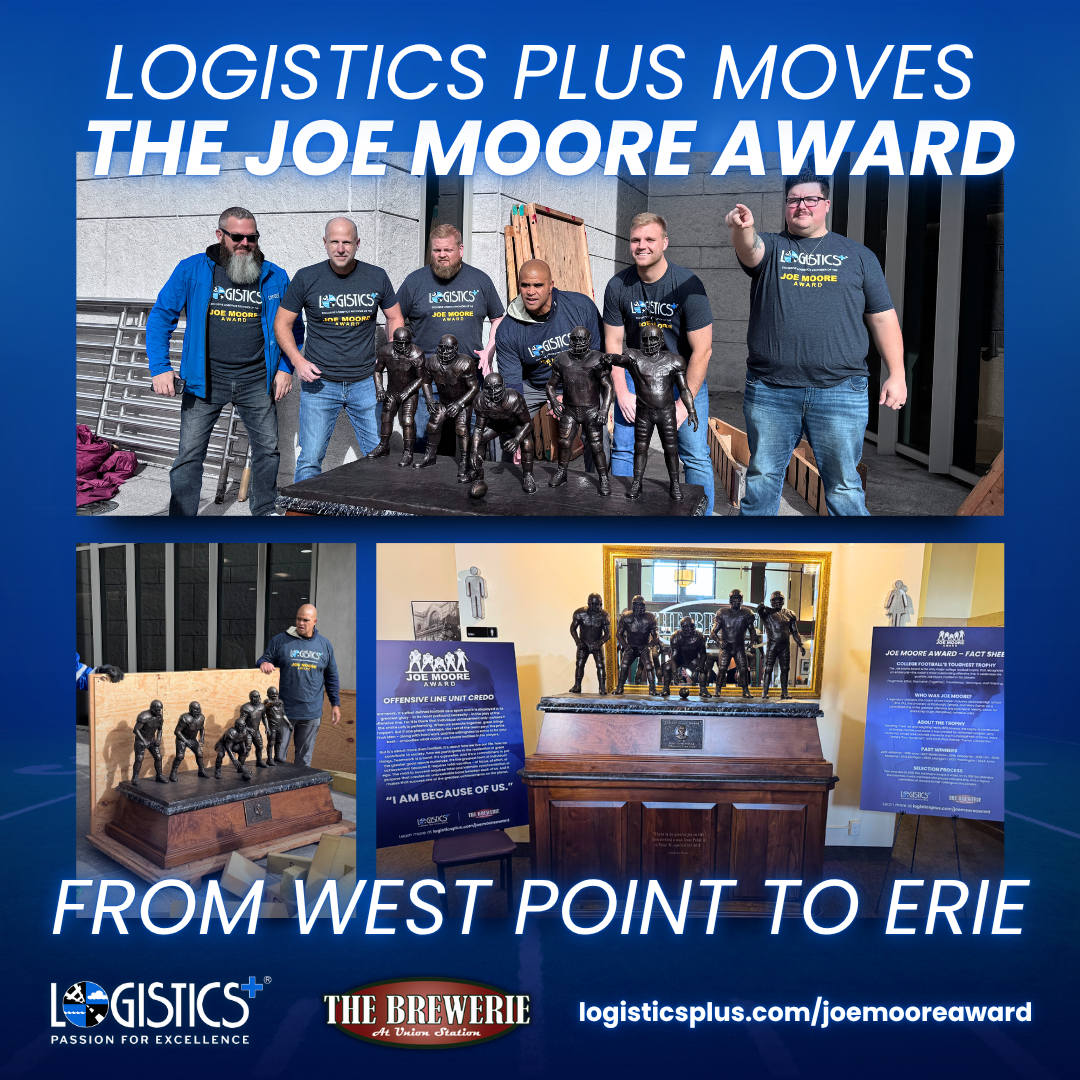
by Scott Frederick | Nov 20, 2025 | News

Logistics Plus Stands with Kingston Wharves to Launch Joint “Rebuild Jamaica Logistics” Effort
The companies’ combined resources are supporting post-Hurricane Melissa relief, rebuilding, and FF&E projects.
 ERIE, PA (November 20, 2025) – Logistics Plus, Inc. (LP), a global leader in transportation, logistics, and unique supply chain solutions, announced its support for Rebuild Jamaica Logistics, a partnership with Kingston Wharves Limited (KWL). The initiative empowers businesses, organizations, and communities to move freight and materials into Jamaica as the country rebuilds following the devastation of Hurricane Melissa.
ERIE, PA (November 20, 2025) – Logistics Plus, Inc. (LP), a global leader in transportation, logistics, and unique supply chain solutions, announced its support for Rebuild Jamaica Logistics, a partnership with Kingston Wharves Limited (KWL). The initiative empowers businesses, organizations, and communities to move freight and materials into Jamaica as the country rebuilds following the devastation of Hurricane Melissa.
As Jamaica begins recovery efforts, Kingston Wharves is serving as the primary gateway and community connection point, coordinating local logistics and providing essential handling, customs, and distribution services.
Logistics Plus is honored to stand beside KWL, offering global reach, supplier coordination, and international freight forwarding through its worldwide network. From its Miami, Florida, warehouse, Logistics Plus is already managing freight consolidation and forwarding services to Jamaica. As a project-cargo specialist, LP is also equipped to handle large-scale shipments for infrastructure, energy, and hospitality projects.
“With so much recovery work ahead, Kingston Wharves is perfectly positioned as Jamaica’s trusted local logistics leader,” said Frank Knafelz, Senior Vice President for Logistics Plus. “LP is grateful to partner with KWL and play our part in helping Jamaica rebuild—bringing global expertise, supplier access, and project support wherever needed.”
KWL’s extensive local role includes customs clearance, warehousing, inland transport, and final-mile delivery across the island. Logistics Plus complements this with international consolidation, air and ocean forwarding, procurement support, and specialized project cargo and FF&E logistics—an area where the LP/KWL partnership has already proven success in serving Jamaica’s hospitality sector.
“This united effort ensures Jamaica receives the materials and support it needs to rebuild stronger than before,” said Mark Williams, CEO of Kingston Wharves Limited. “KWL remains committed to serving our country, and we value LP’s global strength and partnership in this mission.”
Businesses or organizations seeking to ship materials or supplies to Jamaica can visit logisticsplus.com/rebuildjamaica or email rebuildjamaica@logisticsplus.com for more information.
About Kingston Wharves Limited
Kingston Wharves Limited (KWL) is the leading multipurpose port terminal operator and logistics provider in the Caribbean, boasting decades of experience. The company has strong connections to the hospitality industry and plans to leverage its partnership with Cargo Handlers Limited, based in Montego Bay, which has extensive expertise in hospitality logistics and supply chain management. KWL’s unique experience and synergies position it well to support hotel furniture, fixtures, and equipment (FF&E) and logistics projects throughout the island. Learn more at kingstonwharves.com.
About Logistics Plus, Inc.
Logistics Plus, Inc. is a 21st Century Logistics Company™. With annual global sales approaching $1 billion, Logistics Plus is a leading global provider of transportation, warehousing, fulfillment, logistics, project management, business intelligence, technology, and unique supply chain solutions. The company is recognized as one of the fastest-growing privately owned logistics companies, with a presence in over 50 countries worldwide. With its trademark Passion for Excellence™, Logistics Plus is consistently recognized as a great place to work and a top global logistics provider. Learn more at logisticsplus.com.




by Scott Frederick | Nov 18, 2025 | News
 As the Exclusive Logistics Provider of the Joe Moore Award, Logistics Plus managed its inaugural move of the 7-foot, 800-pound trophy from the Army Military Academy campus at West Point, NY, to Erie, PA. The trophy will reside at the Logistics Plus Global Headquarters in Union Station (in The BrewErie on the first floor) for the next few weeks to celebrate the legacy of Joe Moore and the Joe Moore Award.
As the Exclusive Logistics Provider of the Joe Moore Award, Logistics Plus managed its inaugural move of the 7-foot, 800-pound trophy from the Army Military Academy campus at West Point, NY, to Erie, PA. The trophy will reside at the Logistics Plus Global Headquarters in Union Station (in The BrewErie on the first floor) for the next few weeks to celebrate the legacy of Joe Moore and the Joe Moore Award.
Joe Moore began his coaching career at McDowell High School in Erie before coaching at Pittsburgh, Temple, and Notre Dame. A number of his family members were on hand in Erie for the arrival of the trophy, as were members of the McDowell and Erie High School football squads. Also on hand were several of the players whom Joe Moore coached during his time at McDowell from 1963 to 1971.
Erie News Now has been providing complete coverage of the move. Some of those links can be found at the bottom of the logisticsplus.com/joemooreaward web page or on the erienewsnow.com website. The Joe Moore Award media team captured a full accounting of the move, with many interviews, and will be sharing that content soon on the Trench Life channel on YouTube. Logistics Plus will also share that footage when it becomes available. In the meantime, here is a sneak peek at the historical logistical move that took place over the past two days.

by Scott Frederick | Nov 6, 2025 | News

Logistics Plus Expands European Operations with New Spain Division
The new branch in Barcelona positions the company for further growth across Spain and Portugal.

Salvador Martín and Frederic Solàs are pictured above with the new location of the LP Spain Barcelona office building on the right.
ERIE, PA (November 6, 2025) – Logistics Plus, Inc. (LP), a global leader in transportation, logistics, and unique supply chain solutions, is proud to announce the opening of Logistics Plus Spain (LP Spain), headquartered in Barcelona. The new branch is being led by CEO Salvador Martín and Managing Director Frederic Solàs, two seasoned logistics professionals with extensive experience in international freight forwarding and project cargo operations.
“We are excited to launch Logistics Plus Spain and bring the company’s global capabilities to our local market,” said Salvador Martín, CEO of LP Spain. “Our goal is to build a strong and agile team that delivers exceptional service, grows across Iberia, and contributes to the continued success of Logistics Plus worldwide.”
The launch of LP Spain marks another strategic milestone for Logistics Plus and its continued global expansion. The Barcelona office will initially focus on project logistics, import and export management, customs brokerage, warehousing, local transport, and supporting the company’s growing European network. Plans are already underway to expand operations into other possible locations in Spain and Portugal.
“Spain represents a critical link in Europe’s logistics chain—connecting Northern Africa, the Mediterranean, and Western Europe,” said Yuriy Ostapyak, COO for Logistics Plus. “Salvador and Frederic bring tremendous expertise, energy, and local relationships to our organization. With their leadership, LP Spain will play a key role in advancing our mission to say yes to any supply chain challenge, anywhere in the world.”
With this new office, Logistics Plus now has active operations in more than 55 countries, with over 20 located in Europe. LP Spain will collaborate closely with other regional offices, including Logistics Plus France, Germany, Belgium, the Netherlands, and the United Kingdom, to deliver end-to-end supply chain solutions for customers throughout the Iberian Peninsula and beyond.
About Logistics Plus, Inc.
Logistics Plus, Inc. is a 21st Century Logistics Company™. With annual global sales approaching $1 billion, Logistics Plus is a leading global provider of transportation, warehousing, fulfillment, logistics, project management, business intelligence, technology, and unique supply chain solutions. The company is recognized as one of the fastest-growing privately owned logistics companies, with a presence in over 50 countries worldwide. With its trademark Passion for Excellence™, Logistics Plus is consistently recognized as a great place to work and a top global logistics provider. Learn more at logisticsplus.com.




by Scott Frederick | Oct 23, 2025 | News

Logistics Plus Unveils Joe Moore Award Mural in Downtown Erie
Local artist Jason Mumford brings the national football honor to life on the Erie Times-News building.
 ERIE, PA (October 23, 2025) – Logistics Plus, Inc. (LP), a global leader in transportation, logistics, and unique supply chain solutions, in partnership with local Erie muralist Jason Mumford and the Joe Moore Award (JMA) foundation, hosted a ceremony to officially unveil a new 25×40 foot, large-scale mural celebrating the prestigious Joe Moore Award, college football’s top honor for offensive linemen.
ERIE, PA (October 23, 2025) – Logistics Plus, Inc. (LP), a global leader in transportation, logistics, and unique supply chain solutions, in partnership with local Erie muralist Jason Mumford and the Joe Moore Award (JMA) foundation, hosted a ceremony to officially unveil a new 25×40 foot, large-scale mural celebrating the prestigious Joe Moore Award, college football’s top honor for offensive linemen.
The mural, painted on the side of the LP Erie Times-News building on 12th Street, showcases Erie’s connection to the national award, the legendary coach behind it, and adds to the city’s growing collection of public art. As announced earlier this year, Logistics Plus is the Exclusive Logistics Provider of the Joe Moore Award.
“It’s an honor to create something that connects Erie to a national story,” said muralist Jason Mumford. “I hope everyone who drives by this mural feels a sense of pride in Erie and what we can achieve together.”
“We love finding ways to give back to our hometown while celebrating the things that make Logistics Plus unique,” said Jim Berlin, Founder & CEO of Logistics Plus. “This mural captures the spirit of teamwork that defines the Joe Moore Award and our company. It’s a reminder that big things happen when people work together.”
Learn more about Logistics Plus and the Joe Moore Award at logisticsplus.com/joemooreaward.
Erie Times-News / GoErie.com provided some coverage of the event, which included legendary Bills quarterback Jim Kelly making an appearance.
https://www.goerie.com/story/sports/nfl/2025/10/23/pro-football-hall-of-famer-jim-kelly-in-erie-for-jes-speaker-series/86667286007/
Erie News Now posted the following Live coverage on its Facebook page.
The following photographs were taken at the event by rfrankmedia.com.
![Joe Moore Award Mural Event]()
About Logistics Plus, Inc.
Logistics Plus, Inc. is a 21st Century Logistics Company™. With annual global sales approaching $1 billion, Logistics Plus is a leading global provider of transportation, warehousing, fulfillment, logistics, project management, business intelligence, technology, and unique supply chain solutions. The company is recognized as one of the fastest-growing privately owned logistics companies, with a presence in over 50 countries worldwide. With its trademark Passion for Excellence™, Logistics Plus is consistently recognized as a great place to work and a top global logistics provider. Learn more at logisticsplus.com.




by Scott Frederick | Oct 16, 2025 | News

Logistics Plus to Host Unveiling Ceremony for the Joe Moore Award Mural in Downtown Erie
The ceremony will take place on Wednesday, October 22, 2025, at 5:15 pm at 205 West 12th Street.
ERIE, PA (October 16, 2025) – Logistics Plus, Inc. (LP), in partnership with local Erie muralist Jason Mumford and the Joe Moore Award (JMA) foundation, will host a ceremony to officially unveil a new large-scale mural celebrating the prestigious Joe Moore Award, college football’s top honor for offensive linemen. The mural, painted on the side of the LP Erie Times-News building on 12th Street, showcases Erie’s connection to the national award and adds to the city’s growing collection of public art. Logistics Plus is the Exclusive Logistics Provider of the Joe Moore Award.
 WHO:
WHO:
• Jim Berlin, Founder & CEO, Logistics Plus
• Jason Mumford, Erie Muralist & Artist
• Special footbal guest
• Local officials and community leaders
• Logistics Plus employees
• Media representatives
WHEN:
October 22, 2025, at 5:15 pm EDT.
This is a rain-or-shine event. In the event of inclement weather, the dedication and remarks will be held indoors at the Logistics Plus Erie Times-News building (front lobby). Photos can then be taken once the skies clear.
WHERE:
Logistics Plus Erie Times-News Building
205 West 12th Street
Erie, PA 16501
WHY:
This new mural highlights Erie’s connection to this nationally recognized college football award and the legendary coach behind it, celebrates local artistry, and demonstrates LP’s continued commitment to investing in the Erie community.
VISUALS:
• Mural unveiling ceremony with community leaders
• The completed Joe Moore Award mural
• Time-lapse video of the mural painting
• Interviews with Jason Mumford and Jim Berlin
Learn more at logisticsplus.com/joemooreaward.
About Logistics Plus, Inc.
Logistics Plus, Inc. is a 21st Century Logistics Company™. With annual global sales approaching $1 billion, Logistics Plus is a leading global provider of transportation, warehousing, fulfillment, logistics, project management, business intelligence, technology, and unique supply chain solutions. The company is recognized as one of the fastest-growing privately owned logistics companies, with a presence in over 50 countries worldwide. With its trademark Passion for Excellence™, Logistics Plus is consistently recognized as a great place to work and a top global logistics provider. Learn more at logisticsplus.com.



Page 2 of 46«12345...102030...»Last »


 ERIE, PA (November 20, 2025) – Logistics Plus, Inc. (LP), a global leader in transportation, logistics, and unique supply chain solutions, announced its support for Rebuild Jamaica Logistics, a partnership with Kingston Wharves Limited (KWL). The initiative empowers businesses, organizations, and communities to move freight and materials into Jamaica as the country rebuilds following the devastation of Hurricane Melissa.
ERIE, PA (November 20, 2025) – Logistics Plus, Inc. (LP), a global leader in transportation, logistics, and unique supply chain solutions, announced its support for Rebuild Jamaica Logistics, a partnership with Kingston Wharves Limited (KWL). The initiative empowers businesses, organizations, and communities to move freight and materials into Jamaica as the country rebuilds following the devastation of Hurricane Melissa.


 As the Exclusive Logistics Provider of the Joe Moore Award, Logistics Plus managed its inaugural move of the 7-foot, 800-pound trophy from the Army Military Academy campus at West Point, NY, to Erie, PA. The trophy will reside at the Logistics Plus Global Headquarters in Union Station (in
As the Exclusive Logistics Provider of the Joe Moore Award, Logistics Plus managed its inaugural move of the 7-foot, 800-pound trophy from the Army Military Academy campus at West Point, NY, to Erie, PA. The trophy will reside at the Logistics Plus Global Headquarters in Union Station (in 


 ERIE, PA (October 23, 2025) – Logistics Plus, Inc. (LP), a global leader in transportation, logistics, and unique supply chain solutions, in partnership with local Erie muralist Jason Mumford and the Joe Moore Award (JMA) foundation, hosted a ceremony to officially unveil a new 25×40 foot, large-scale mural celebrating the prestigious
ERIE, PA (October 23, 2025) – Logistics Plus, Inc. (LP), a global leader in transportation, logistics, and unique supply chain solutions, in partnership with local Erie muralist Jason Mumford and the Joe Moore Award (JMA) foundation, hosted a ceremony to officially unveil a new 25×40 foot, large-scale mural celebrating the prestigious 
